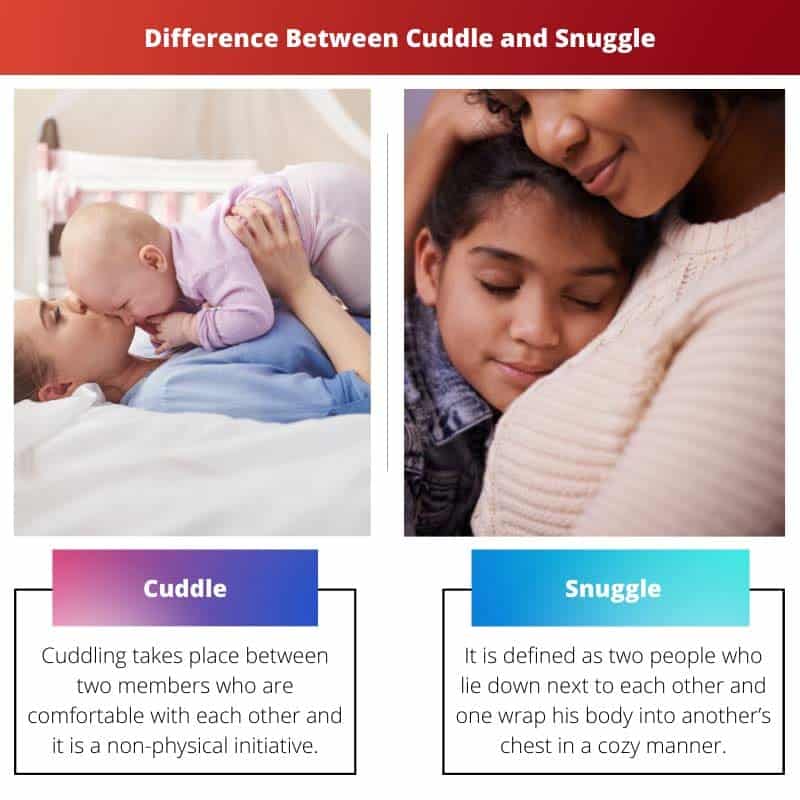Falling in love and staying in love are two different stages that need different levels of dedication and commitment. This could be very well expressed by affection, like hugging, kissing, spending time with your loved ones, respecting each other, cuddling, compromising, etc.
Wait! If cuddling is an expression of love, then what about snuggle?
Even though people think cuddling and snuggling mean the same thing and can be interchanged sometimes, that is not the truth. There are “small” variations to both these intriguing words, which intrigue the feeling of warmth and sympathy.
Key Takeaways
- Cuddling is an affectionate act in which two or more people hold each other close, while sitting or lying down, providing comfort and a sense of security.
- Snuggling is similar to cuddling but involves nestling or burrowing oneself into a cozy position, against another person or a soft surface like a pillow or blanket.
- Both cuddling and snuggling involve close physical contact and provide emotional comfort, but snuggling specifically includes nestling into a cozy position.
Cuddle vs Snuggle
The difference between cuddling and snuggling is the crucial role of intimacy in it. Cuddling does not just happen between two human souls; you can cuddle with any of your family members, your best friends (indeed, not in a weird way), pets, children, etc.
Snuggling, on the other hand, takes place frequently between lovers, couples, etc.

Comparison Table
| Parameters of the Comparison | Cuddle | Snuggle |
|---|---|---|
| Definition | Cuddling takes place between two members who are comfortable with each other, and it is a non-physical initiative. | It is defined as two people who lie down next to each other, and one wraps his body into another’s chest in a cosy manner. |
| Level of Intimacy | It is not initiated to provoke the sexual desires inside a person. But instead, it gives a sense of comfort and warmth. | Snuggling leads to more sexual desires and is practised as an act of confidentiality. |
| Rule of Exhibition | It is more denoted as a feat of devotion and passion. | It can be regarded as a sexual appetite that occurs when someone is high on ” to |
| Who is the master? | Cuddling can be between a master and a pet, a mother and a child, or between a couple in the early stages of their relationship. | Snuggling happens between two people in a serious relationship, like a husband and wife. |
| Mode of elements | Both legs and arms can be utilized to initiate this deed. | A major part of your body is used here to snuggle with your significant one. |
What is Cuddle?
Cuddling is an act of compassion that takes place between two individuals. It is an intimating deed where one person wraps their arms around another person’s body.
Cuddling is a beautiful way of expressing how much you care about a person and gives out many messages without even talking.
Cuddling conveys, “It’s okay; everything is going to be alright.” Cuddling occurs in a sleeping or intimate position.
Many confuse hugging with cuddling. Hugging is like welcoming someone.
Unlike cuddling, hugging happens between two people who are in a standing position. Cuddling releases a hormone called oxytocin, also known as the love hormone, which helps a great deal for newborn “mothers” in breastfeeding and de-stressing, increases the level of comfort, etc.

What is Snuggle?
Snuggle is much like a cuddle, but it has more of a physical attraction in it. It involves two people who want to be together in a cosy space and enjoy each other’s warmth and comfort.
Snuggling is mainly considered a sexual interaction between partners who are sexually involved, couples, etc. It takes place in a lying position, and unlike cuddling, it can last for many hours.
One can even snuggle alone while watching a movie or if one wants to relax calmly.
People who snuggle more during their bedtime or maybe after a long workday have indicated signs of a solid and everlasting bond between them.

Main Differences Between Cuddle and Snuggle
- One of the significant differences between a cuddle and a snuggle is cuddling is not a physical act of affection. In contrast, snuggling happens more between couples who have increased levels of sexual desire.
- The word cuddling was found in the 16th century before snuggling existed in the 17th century.
- The best example to explain cuddling is the growing fondness between a mother and a newborn baby. But snuggling is common for newly married couples.
- Cuddling releases oxytocin, also known as the feel-good hormone that has a lot of benefits for newborn children.
- Snuggling your partner can awaken the sexual intentions in you and your spouse as the dopamine hormone gets released into the environment.
- There are many kinds of cuddling, among which spooning is well-known. Snuggling is one of a kind deed and has no significant divisions too.


The analysis of cuddling and snuggling from a historical perspective provides a unique dimension to this comparison. It’s a captivating exploration of how these acts have evolved over time.
Absolutely, Osmith. The historical insight enhances the overall narrative of this article.
I couldn’t have said it better, Osmith. The historical context adds depth to the comparison, enriching our understanding of these expressions of endearment.
The comparison between cuddling and snuggling showcases the multifaceted nature of human connections. It’s a compelling read that delves into the intricacies of emotional expression.
I couldn’t agree more, Rachel61. It’s a thought-provoking examination of the depth of human intimacy and affection.
Absolutely, Rachel61. The article offers a nuanced perspective on the diverse ways in which we communicate and connect with others.
The distinction between cuddling and snuggling is both amusing and enlightening. The comparison table offers a lighthearted yet informative view of these expressions of affection.
I see what you mean, David. The article presents the differences in a light-hearted manner, making it an engaging read.
Agreed, David. It’s a delightful yet educational take on these expressions of warmth and intimacy.
The detailed comparison between cuddling and snuggling provides valuable insights into the emotional, physical, and historical aspects of these expressions of affection. It’s a well-researched and thought-provoking piece.
I share your sentiments, Xmorgan. The depth of analysis in this article makes it an enriching resource for understanding the complexities of human intimacy.
Absolutely, Xmorgan. The article’s comprehensive approach leaves readers with a profound understanding of cuddling and snuggling.
This article meticulously dissects the differences between cuddling and snuggling, providing readers with a comprehensive understanding of these expressions of intimacy. It’s a valuable resource for anyone interested in this topic.
Indeed, Nstewart. The attention to detail in the comparison is commendable, offering a rich discussion on the emotional and physiological aspects of these acts.
The detailed comparison shows the depth of human interactions and the various ways we express affection. This article is an insightful exploration of the emotional connections between people.
I couldn’t agree more, Patrick. It offers a thought-provoking analysis of interpersonal relationships and the significance of physical touch.
I find the distinction between cuddling and snuggling quite intriguing. The level of intimacy and physical attraction is very well described. It certainly provides a new perspective on expressions of affection.
Absolutely, Arthur. It’s fascinating to analyze the nuances of each action and understand the emotional and physiological impact they have.
This article provides a comprehensive comparison between cuddling and snuggling, highlighting their physical and emotional aspects. It’s a very helpful guide for those who are interested in differentiating between the two.
I agree, Patricia. The article does a great job of explaining the differences in a clear and informative manner.
The exploration of oxytocin and its role in cuddling offers a fresh perspective on the physiological aspects of affectionate behaviors. It’s a compelling addition to this comparison.
Well said, Wjames. The focus on oxytocin provides a fascinating insight into the psychological and physiological implications of cuddling.
I agree, Wjames. It’s intriguing to learn about the influence of hormones on our emotional experiences.
I appreciate the scientific and psychological insights into cuddling and snuggling. It’s enlightening to learn about the hormonal and emotional effects associated with these expressions of closeness.
Absolutely, Natalie. The article combines scientific knowledge with emotional understanding, providing a holistic view of these intimate actions.